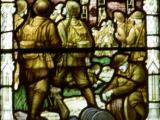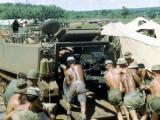Events In History
Returning from leave in Laos, 30-year-old Malcolm ‘Mac’ Riding was on board an Air Vietnam DC4 when it crashed 25 km from his Red Cross team’s compound near Pleiku, South Vietnam.
Prime Minister Keith Holyoake’s statement in Parliament that New Zealand’s combat force would be withdrawn before the end of the year coincided with a similar announcement by the Australian government.
Anti-war protesters disrupted a civic reception in Auckland for New Zealand soldiers returning from the Vietnam War.
United States Vice-President Spiro Agnew’s three-day visit to New Zealand sparked some of the most violent anti-Vietnam War demonstrations seen in this country.
President Lyndon Johnson's 24-hour visit was aimed at shoring up support for the war in Vietnam. Protesters were outnumbered by enthusiastic crowds.
Gunners of 161 Field Battery fired New Zealand’s first shots of the Vietnam War from their base at Bien Hoa, near Saigon.
On Anzac Day 1963, a six-strong New Zealand civilian surgical team arrived in Qui Nhon, South Vietnam as part of the Colombo Plan assistance programme. Their deployment marked the beginning of New Zealand’s involvement in the Vietnam War.
Articles
Links - military history

Links to military resources including personnel records, medal winners and war graves. Read the full article
Page 5 - Post Second World War
Links to further information about New Zealand's military participation since the Second World
The Cold War

Although the origins of the so-called Cold War can be traced back to the Bolshevik revolution of 1917, this intense ideological struggle between the Western powers and the Soviet Union really began after the Second World War.Read the full article
Page 2 - Overview
New Zealand’s participation in the Cold War was shaped by its decision to support the Western powers in their confrontation with the Soviet Union after the Second World War.
Page 4 - Treaties and alliances
During the 1940s and 1950s New Zealand signed a series of collective treaties with Britain and the United States aimed at countering the threats of Japanese military resurgence
Page 5 - South-East Asia
During the 1950s the focus of New Zealand’s defence strategy shifted from the Middle East to Asia.
Page 6 - Protest and dissent
The end of the Vietnam War shifted the focus of the Cold War away from Asia and New Zealand's need for ‘forward defence’ diminished. These changes, together with the anti-Vietnam
Vietnam War

The Vietnam War was New Zealand's longest and most controversial overseas military experience. Although this country's troop commitment and casualties were modest, the conflict aroused widespread protest and condemnation. And for those who fought in Vietnam, it was a tough homecoming.Read the full article
Page 1 - The Vietnam War
The Vietnam War was New Zealand's longest and most controversial overseas military experience. Although this country's troop commitment and casualties were modest, the conflict
Military mascots

New Zealanders have one of the highest pet-ownership rates in the world. Wartime was no different. Take a tour through a menagerie of military mascots: dogs, cats, donkeys, monkeys, pigs, goats and birds. There's the famous bull terrier Major Major, along with the less well-known, but very cute, slow loris adopted by 1 RNZIR in Borneo.Read the full article
Page 4 - Other military mascots
Mascots we would like more information about, mainly from post-Second World War
The 1960s
Five decades ago most Kiwis enjoyed a standard of living that was the envy of other nations. During the 1960s the arrival of TV and jet airliners shrank our world, and New Zealanders began to express themselves on a range of international issues, including opposition to the Vietnam War.Read the full article
Page 8 - 1965 - key events
A selection of the key events in New Zealand history from
Page 9 - 1966 - key events
A selection of the key events in New Zealand history from
The Royal New Zealand Navy
Seventy years old in October 2011, the Royal New Zealand Navy is today an integral part of the New Zealand Defence Force. But its 1941 establishment was the result of a long process of naval development.Read the full article
Page 6 - Post-war operations
Like all the services the RNZN faced difficulties of readjustment to peacetime conditions, not only in drastically reducing numbers but also in determining the shape of the































